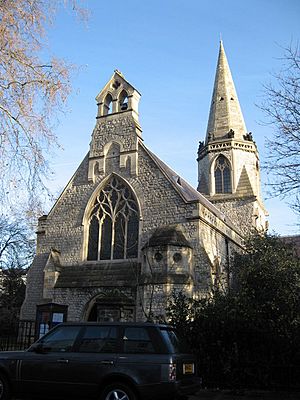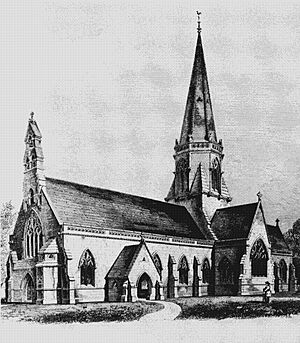St Mary The Boltons facts for kids
Quick facts for kids St Mary The Boltons |
|
|---|---|

St Mary The Boltons
|
|
| Lua error in Module:Location_map at line 420: attempt to index field 'wikibase' (a nil value). | |
| Location | Brompton, London |
| Country | United Kingdom |
| Denomination | Church of England |
| Churchmanship | Central |
| History | |
| Dedicated | 1850 |
| Architecture | |
| Years built | 1849–50 |
| Administration | |
| Diocese | London |
St Mary The Boltons is a church in London, part of the Church of England. You can find it in an area called The Boltons in Brompton. It's a very special building because it's a Grade II listed building. This means it's an important historical building that needs to be protected.
Contents
History of the Church
The area around The Boltons was mostly farmland until the mid-1800s. A man named Robert Gunter the elder decided to build a new neighborhood there. He wanted to include a church to make the area even nicer.
Building the Church
The church was designed by George Godwin. He also designed other churches in London. St Mary The Boltons was actually built before most of the houses in the new neighborhood. Robert Gunter gave the land for the church.
It was the first new parish (a church's local area) to be created from the much larger Holy Trinity, Brompton parish. Building the church cost about £6,000 back in 1850. The Church Building Commission also gave a small grant to help. The church officially opened on October 22, 1850. The first vicar, Rev. Hogarth J. Swale, paid for most of the building costs himself.
Parish Growth
In July 2006, St Mary's Parish became much bigger. It joined with the parish of St Jude's, Courtfield Gardens. This meant the church now served twice as many people in the area.
Church Architecture and Design
The church is built from stone. Outside, it uses Kentish ragstone with Bath stone caps. Inside, it uses a stone called Hassock.
Changes Over Time
The walls inside the church are plain now. But long ago, they had beautiful painted designs of fruit and flowers. The windows used to have colorful stained glass, but now they are clear.
In 1854, a tall spire was added to the church. Later, in 1902, new wooden pews and floor tiles were put in.
World War II Damage and Repair
During World War II, German bombs damaged the church's roof and organ. Many windows were broken. After the war, the church was repaired. The altar was moved, and a new Lady Chapel was created. A new east window, designed by Margaret Kaye, was installed in 1955.
In 1960, the old organ was moved to another church. A new organ was then installed in the west end of St Mary The Boltons. A special west window was also added to help control the sunlight, which kept the new organ in tune.
Graveyard
The church graveyard is the final resting place for some interesting people.
- Farnham Maxwell-Lyte (1828–1906) was a chemist and photographer.
Notable Clergy
Some important people who later became well-known served as clergy at St Mary The Boltons.
- W. Montgomery Watt was a curate here from 1939 to 1941. He later became a professor who studied Arabic and Islamic cultures at the University of Edinburgh.
- Geoff Davies also served as a curate here. He later became a bishop in the Anglican Church of Southern Africa.
See also


